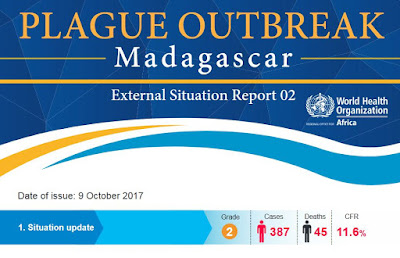#12,807
A week ago, the WHO was reporting 132 cases of plague on the island of Madagascar, with 73 of those being pneumonic plague, which can be transmitted from human to human via respiratory droplets or bodily fluids, and which normally only makes up about 10% of plague cases.
While yearly outbreaks of bubonic plague have become common in Madagascar, they generally peak in November or December, and occur in the rural highlands of the island, above the 800 meter level.What makes this year's outbreak different and worrying is that cases started early, are mostly pneumonic plague (not bubonic), and cases are occurring at lower elevations and in urban settings.
Earlier today we saw a Rapid Risk Assessment from the ECDC, and this afternoon the WHO has released a new SitRep which doubles - since last Thursday's update - the number of cases on the island. The Epi Curve graphic (below) shows the dramatic rise in cases this past week.
Some excerpts from today's report (but download the full PDF) follow:
Situation update
The outbreak of plague in Madagascar continues to evolve. Since our last report on 4 October 2017, a total of 230 new suspected cases including 17 deaths (case fatality rate 7.4%) were reported. Between 1 August and 8 October 2017, a total of 387 cases (suspected, probable and confirmed) including 45 deaths (case fatality rate 11.6%) have been reported from 27 out of 114 districts in the country. Of these, 277 cases (71.6%) had the pneumonic form of the disease, 106 were bubonic plague, one case was septicaemic plague, and 3 cases were unspecified.
Of 279 cases reported to the Central Plague Laboratory of the Institut Pasteur of Madagascar, 38 were confirmed by polymerase chain reaction (PCR), 113 were classified as probable cases after testing positive on rapid diagnostic tests (RDT) and 123 remain suspected cases, pending results. Fourteen (64%) out of 22 regions in the country (including the North and South-east Regions that are considered non-endemic) have been affected. At least eight healthcare workers from one district health hospital have contracted plague since 30 September 2017.
Plague is known to be endemic on the Plateaux of Madagascar (including Ankazobe District where the current outbreak originated) and a seasonal upsurge (predominantly the bubonic form) usually occurs early every year between September and April. Unlike the usual endemic pattern, the plague season begun early this year, and the current outbreak has affected major urban centres, including Antananarivo (the capital city) and Toamasina (the port city).
There are three forms of plague, depending on the route of infection: bubonic, septicaemic and pneumonic (for more information, see the link http://www.who.int/mediacentre/factsheets/fs267/en/).
Current risk assessment
While the current outbreak was triggered by the occurrence of one large epidemiologically-linked cluster, cases of pneumonic plague without apparent epidemiological links have since been detected in 14 regions across the country, including densely population cities of Antananarivo and Toamasina. Due to the increased risk of further spread and severe nature of disease, the overall risk at the national level is considered very high. The overall regional risk remains moderate due to frequent travel (by air and sea) to neighbouring Indian Ocean islands and several other African countries. The overall global risk is perceived to be low.
The risk assessment will be re-evaluated by the three levels of WHO based on the evolution of the situation and the available information.(Continue . . )
The last major urban outbreak of plague in the United States occurred in 1924-25 in Los Angeles. Since then, only scattered cases have been reported, with about 7-15 cases each year in the U.S..
According to the CDC: Between 1,000 and 2,000 cases each year are reported to the World Health Organization(WHO), though the true number is likely much higher.
The last really big plague outbreak was in India over 20 years ago.Although there is no vaccine available, with the advent of effective antibiotics, large scale outbreaks of plague have become increasingly rare. That said, the high incidence of pneumonic plague - particularly in crowded urban settings - makes the situation in Madagascar particularly fluid.
The WHO cautions:
As this is a rapidly changing situation, the reported number of cases and deaths, contacts being monitored and the laboratory results are subject to change due to enhanced surveillance, contact tracing activities, ongoing laboratory investigations, reclassification, and case, contact and laboratory data consolidation.

